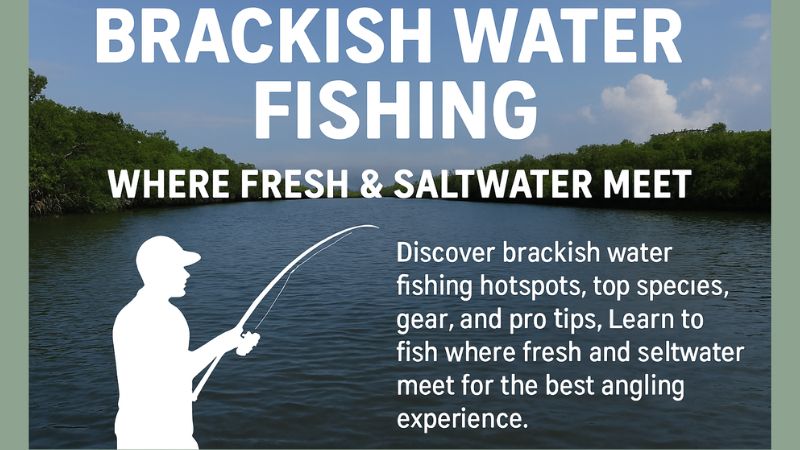Brackish Water Fishing: The Ultimate Guide to Where Fresh and Saltwater Meet
When two worlds collide; freshwater flowing downstream and saltwater pushing inland; an entirely unique and dynamic ecosystem emerges. Brackish water is nature’s ultimate mixing bowl, creating nutrient-rich environments that explode with biodiversity and offer a fishing experience unlike any other. This guide will cover everything you need to know, from the science of salinity to the best gear and techniques for landing a trophy fish.
What Is Brackish Water? The Angler’s Goldmine
Definition & Salinity Range
Brackish water is the quirky middle child between freshwater and saltwater. Technically, it occupies a salinity spectrum between 0.5 and 30 parts per thousand (ppt). This means it’s saltier than a river but less salty than the open ocean. Its conditions are constantly in flux due to tides, rainfall, evaporation, and river discharge.
Where It Forms: Estuaries, Deltas, and Lagoons
You can find these productive waters in several key formations:
- Estuaries: The mouths of rivers where they meet the tidal saltwater.
- Deltas: Sediment-rich areas where rivers branch out before meeting the sea (e.g., Mississippi Delta).
- Coastal Lagoons: Shallow bodies of water separated from the ocean by sandbars but connected via one or more inlets (e.g., Indian River Lagoon).
- Tidal Rivers & Creeks: Any river or creek far inland that is still influenced by the ocean’s tides.
Why Anglers Love It
- Unmatched Diversity: You can catch freshwater and saltwater species, often in the same spot.
- Nutrient-Rich: High nutrient levels mean more baitfish, which in turn attract more large predators.
- Ever-Changing: The constant shift in conditions makes every trip a new puzzle to solve.
Ecosystems & Fish Behavior: Reading the Water
The Role of Salinity
Fish have preferred salinity “comfort zones.” Changes in tides and rainfall can dramatically shift their locations.
- Example: Striped bass follow cooler, slightly saline waters during migration. Snook will move when salinity spikes after a drought.
Seasonal Patterns
- Spring: Influx of freshwater from snowmelt/rain triggers spawning migrations.
- Summer: Warmer water pushes some species closer to inlets with cooler, oxygen-rich tidal flow.
- Fall: Peak feeding activity before winter makes this ideal for trophy catches.
- Winter: Species retreat to deeper, more stable salinity zones to conserve energy.
Key Habitat Types to Target
- Mangrove Forests: Act as nursery areas for juvenile fish; perfect for ambush predators.
- Salt Marshes: Baitfish nurseries and rich feeding grounds for predators.
- Rock Jetties & Bridge Pilings: Structure-oriented predators gather here to feed on crustaceans and baitfish.
- Deep Channels: Provide refuge for fish during extreme temperature or salinity shifts.
World-Class Brackish Fishing Destinations
| Location | Country/Region | Key Species |
|---|---|---|
| Chesapeake Bay | USA | Striped Bass, Red Drum, Croaker |
| Indian River Lagoon | Florida, USA | Snook, Tarpon, Redfish |
| Sundarbans | Bangladesh/India | Barramundi, Catfish, Threadfin |
| Mekong Delta | Vietnam | Catfish, Snakehead, Barramundi |
Don’t overlook local spots! Look for river mouths, tidal creeks, or lagoons connected to the sea. You can identify brackish zones by their slightly murky, tea-colored water and the presence of both freshwater and saltwater vegetation.
Popular Brackish Water Species
- Red Drum (Redfish): Strong fighters tolerant of varied salinity. Thrive in shallow grassy flats and marsh edges. Best Baits: Live shrimp, finger mullet, gold spoons.
- Snook: Estuary ambush predators, often found near structure. Sensitive to cold water. Best Baits: Live pinfish, soft plastic jigs, topwater plugs.
- Striped Bass: Anadromous (migrates between fresh/salt). Loves tidal rivers during migration seasons. Best Baits: Bucktail jigs, live eels, topwater poppers.
- Flounder: Masters of camouflage that ambush prey from sandy/muddy bottoms. Best Baits: Live minnows, jigged artificials, cut bait.
- Sheepshead: Structure lovers that feed on crustaceans clinging to pilings and rocks. Best Baits: Fiddler crabs, shrimp, small pieces of clam.
- Brackish Catfish & Tilapia: Hardy, opportunistic feeders often found in tidal rivers and low-salinity estuaries. Best Baits: Cut bait, worms, prepared catfish bait.
Essential Gear & Tackle
Rods & Reels
- A medium-heavy spinning rod (7 ft) offers the perfect blend of versatility, backbone for fighting strong fish, and sensitivity.
- Pair it with a 3000-4000 size reel with sealed bearings to resist corrosion from salt.
Lines & Leaders
- Mainline: 10–15 lb test braided line for sensitivity and strength.
- Leader: 20–30 lb fluorocarbon leader. Fluorocarbon is essential as it resists abrasion from oyster beds, structure, and is less visible to fish.
Best Baits & Lures
- Live Baits: Shrimp, mud minnows, finger mullet.
- Cut Baits: Mullet chunks, squid strips.
- Artificial Lures: Soft plastic jerkbaits, spoons, topwater poppers, bucktail jigs.
Proven Techniques for Success
- Fish the Tides: The single most important factor. A rising tide pushes baitfish into estuaries, and predators follow. Plan your trip around tidal charts.
- Target Structure: Always work your bait or lure around pilings, oyster beds, fallen trees, and mangrove roots—these are natural ambush points.
- Murky Water Strategies: In low-visibility water, fish rely on vibration and scent. Use loud, rattling lures or scented soft plastics to help them find your offering.
Safety, Regulations & Conservation
- Licensing: Always check local regulations. Some areas require both saltwater and freshwater fishing licenses for brackish zones.
- Catch Limits: Know the size and bag limits for your target species. Regulations are in place to ensure healthy fish populations.
- Eco-Ethics:
- Avoid anchoring in sensitive seagrass or marsh areas.
- Release breeding-size fish to preserve the fishery.
- Use barbless hooks for easier, less damaging release.
- Pack out all trash and leave no trace.
FAQs
Q: Can I use my freshwater gear in brackish water?
A: Yes, but you must rinse it thoroughly with fresh water after each trip to prevent corrosion. For longevity, gear designed for saltwater is better.
Q: What’s the best tide and time for brackish fishing?
A: A rising tide, especially during the low-light periods of early morning or late afternoon, is most productive.
Q: How do I find brackish fishing spots near me?
A: Look for where rivers meet bays, search for tidal creeks on a map, or look for coastal lagoons. Apps like Navionics or Fishbrain can be incredibly helpful.
Why Brackish Water Fishing Is Worth Your Time
Brackish water fishing is the ultimate test of an angler’s adaptability. It’s unpredictable, challenging, and deeply rewarding. One cast could hook a freshwater largemouth bass, the next a saltwater snook. The scenery shifts with the tide, and every trip brings new lessons. It offers the thrill of saltwater species with the accessibility of freshwater environments, making it a perfect gateway to mastering both worlds.

